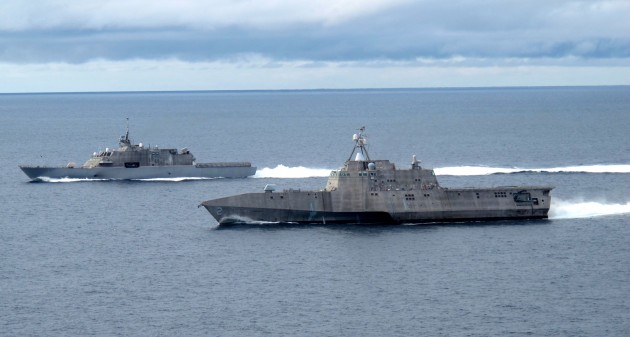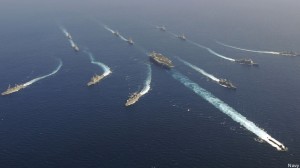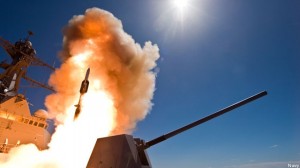Navy Fights For 52 LCS After SecDef Cuts To 40: Presence vs. Warfighting
Posted on

The two Littoral Combat Ship variants, LCS-1 Freedom (far) and LCS-2 Independence (near).
UPDATED: Adds SecDef Carter Memo, Rep. Forbes Questioning Carter Decision, Navy Statement
WASHINGTON: The Navy is not yielding to Defense Secretary Ash Carter’s memo cutting the Navy’s much-maligned Littoral Combat Ship program from 52 of the small ships to 40 and dumping one of the two shipyards building them. Carter plans to use the savings for other Navy programs such as missiles and aircraft, and in addition would add $1.7 billion to the Navy topline over the next five years. But the Navy’s not happy with that trade-off.
The debate between the Navy and the Office of the Secretary of Defense boils down to one fundamental question. Should the Navy focus on day-to-day peacetime demands around the world, aka “presence,” for which LCS is suited, or on the prospect of high-end warfighting against Russia and China, for which it’s not?
“The Navy is still fighting this decision, so maybe this will play out into the next year’s congressional session,” said one source familiar with the program.
“Nothing is finalized just yet,” a defense official told me this morning. So the Navy is not resigned to the numbers in the Carter memo? That’s correct, the official confirmed.
https://www.scribd.com/doc/293552475/Carter-LCS-Cut-to-40-Memo-2015-12-14
So if a memo from the Secretary of Defense himself– first reported by Chris Cavas at Defense News last night — is not the final word, what is? “That’s the direction they want to go, but the ’17 budget to my knowledge has not been locked,” the defense official said. “I wouldn’t steer you away from what you saw in that story [by Cavas] but I would also say the discussions are still ongoing. Nothing’s set in stone yet.”
UPDATE Even an official Navy statement this afternoon, in its refusal to comment, noted that the final decision had not been made: “We are aware of the memo; however budget discussions are pre-decisional. It would be inappropriate to discuss anything further until the FY 17 budget is finalized.”
Defense Secretary Ashton Carter in Silicon Valley
“A Helluva Rebuke To the Navy”
A congressional source who saw the Carter memo disagreed with the idea there was any maneuver room left on LCS: “It reads like a helluva rebuke to the Navy, with the last sentence saying, in effect, ‘end of discussion.'”
That rebuke is most pointed in this passage from the memo:
“For the last several years, the Department of the Navy has overemphasized [increasing] total ship numbers at the expense of critically-needed investments in areas where our adversaries are not standing still,” Carter writes. “Earlier this year this year, the Department of Defense gave guidance to correct and reverse this trend of prioritizing quantity over quality; however, counter to that guidance, the Department of the Navy’s latest program submission fails to do so.”
Then there’s that last sentence, which seems to leave little room for debate: “The Department of Defense is relying on the Department of the Navy to support and carry out these critical strategic decisions.”

Rep. Randy Forbes
2017: The Battle On The Hill
But even if Carter wins the battle inside the administration, he may well lose the war on Capitol Hill. Carter may even be counting on it. It’s an old budgeting gambit to cut something you know Congress will add back, increasing your overall budget in the process. “In light of Congress’s willingness to keep adding to shipbuilding these last few years,” the congressional source noted, “it may be that OSD is hoping that trend will continue and reverse some of these cuts in the appropriations process.”
UPDATE BEGINS The first indication of Hill resistance came this afternoon from a source worth noting: Rep. Randy Forbes, chairman of the House Armed Services seapower subcommittee.
“Secretary Carter has framed this as a choice between capability and capacity, but the undeniable reality is that our Navy needs more of both–and our military needs the top-line budget to make that a reality,” Forbes told us. UPDATE ENDS
Admittedly, legislators have been much more skeptical of LCS than of other, more traditional warships such as destroyers, attack submarines and amphibious assault ships. Senate Armed Services Committee chairman John McCain said in a statement this morning that: “I will not be speculating on media reports. That said, my concerns with the LCS, from cost overruns to schedule delays to poor performance, are well known.”
But Congress has also consistently voted to add vessels to Navy budgets, not to take them away, and Republicans in particular have said the fleet is dangerously undersized. LCS’s critics call it undersized, undergunned, and fragile, but precisely because it’s so much smaller and cheaper than, say, a destroyer, it’s been critical to the Navy’s campaign to bulk up numbers.

The Numbers Game: Quantity vs. Quality
The original plan for 52 Littoral Combat Ships would mean one Navy ship in six was an LCS. But Carter counters: 40 is fine: It’s “the number that the Navy’s own warfighting analysis says is sufficient to need.”
Uh, what study is that? reply our sources familiar with Navy thinking.
“Nobody knows where that came from. That was a surprise,” said the source familiar with the program. “At least, it was a surprise to the PEO [Program Executive Office].”
“I don’t know,” said the defense official when I asked where the 40 figure came from. “What we always go off is the force structure assessment, [and] that’s always been 52.”
There’s a subtle but crucial question of wording here. Carter’s 40-LCS figure comes from a warfighting assessment. The 52-LCS figure comes from a more general assessment of force structure required for all missions, including peacetime presence needs.
The insatiable demands of the theater combatant commanders (COCOMs) for ships to strike terrorists, train allies, contest disputed waters, respond to natural disasters, and so on means that “normal” demands have run the Navy ragged. There’s a vicious circle. A shortage of ships means the ships on hand have to go out longer at the expense of crew rest and maintenance, which means ships break down more often and wear out more quickly, which means the ship shortage gets worse. It’s this cycle that the Navy wants to break.
Part of the solution is new maintenance and deployment schedules, but another part is LCS. Why send a $2 billion Aegis destroyer, designed to shoot down high-end missiles, to do a presence mission that a $500 million LCS can do just as well? The Littoral Combat Ships will also replace a host of very small vessels like patrol craft and minesweepers, using interchangeable mission modules (still being developed) to hunt mines, subs, or Iranian-style fast attack boats. Even LCS advocates agree it does not boast the firepower or durability of a much larger destroyer.
The Navy has tried to square that circle recently with its “distributed lethality” doctrine — summed up by Rear Adm. Peter Fanta as, “if it floats, it fights.” This concept would arm support ships with long-range missiles and network them together so they could concentrate their fire. Distributed lethality wouldn’t turn small presence-mission ships into high-end warfighters, but it would make them much more useful in a high-end scenario. Carter’s predecessor as Defense Secretary, Chuck Hagel, ordered the Navy to build the last 20 LCS as an upgunned “frigate” variant with such long-range anti-ship missiles (Carter would cut this to 12). Fanta has been pushing to backfit current LCS with such weapons as well.

A Navy ship launches an SM-6 missile
What Carter Wants Instead
Distributed lethality, however, doesn’t appear to have appeased Ash Carter. His plan cuts LCS to buy (among other things)
- 31 more F-35C fighters, whose stealth, sensors, networking, and electronic warfare are touted as crucial for a future high-tech war (though the Navy has demonstrated a lack of enthusiasm for the F-35C until recently);
- an unspecified number of additional F/A-18E/F Super Hornets;
- upgrades to a host of existing aircraft and ships, including an additional Virginia Payload Module that massively increases the missile capacity of attack submarines fitted with one;
- and a lot more high-end missiles, both air-to-air AIM-120s and anti-air/missile defense SM-6s. While the Navy had planned to buy SM-6 and other munitions at the “minimum sustaining rate” required to keep factories going, Carter wrote, his plan “will maximize production of SM-6 missiles and maintain procurement of other advanced munitions.”
In short, Carter is willing to accept a smaller fleet but one that hits harder. That’s a completely reasonable plan for warfighting and a terrible trade-off for presence, where the idea is to have lots of ships keeping the peace in lots of places so you don’t have to hit anyone.
The Carter memo displays “very weak reasoning here and a lack of understanding of the nature and role of naval presence,” growled retired Capt. Jerry Hendrix. “There are 18 maritime regions that require constant maritime presence in order to uphold the current international order. LCS, purchased in large numbers was to be key in providing the presence to perform this mission. As it takes five ships to keep one forward deployed, Secretary Carter has effectively gapped two maritime regions, inviting increasing instability or even war. Other nations are ready and willing to step in with an alternative security environment, one not based on free trade and free navigation. This is a bad decision.”
“It’s tough, because we need numbers, but you also need increased warfighting capabilities,” acknowledged the defense official. “The thing is, when you look at ships, there’s a far greater lead time to build and turn out ships than aircraft or weapons.” If you forgo additional planes, missiles, or upgrades to existing ships and aircraft, you can always buy and field them (relatively) fast at a later time, the thinking goes. If you cut shipbuilding, you’ll feel the effects for decades.
But inside the Office of the Secretary of Defense, they’re worried about warfighting capabilities now.
“LCS is not a key element in concepts to defeat anti-access threats such as those in China, Iran, or Russia,” said Bryan Clark, a former aide to the Chief of Naval Operations. “Even though it is intended to address mine warfare and submarines, it is intended to conduct these operations in relatively benign environments because it does not have significant defenses,” he said. “The Navy set itself up for this outcome to a degree by not fully addressing the lack of survivability in LCS, and by planning the new frigate to be essentially the same.”
As a result, Clark continued, “it is not seen as a big contributor to Offset” — the quest for new technologies and tactics to counter rapidly advancing adversaries like Russia and China. “When Bob Work talks about devoting money ($12-14 billion) to implementing the Third Offset Strategy, this is an example of how it will be paid for. “The 12 LCS cut will result in about $6 billion to shift to weapons and other systems such as SM-6 that are directly applicable to the Offset Strategy approach.”
Subscribe to our newsletter
Promotions, new products and sales. Directly to your inbox.
